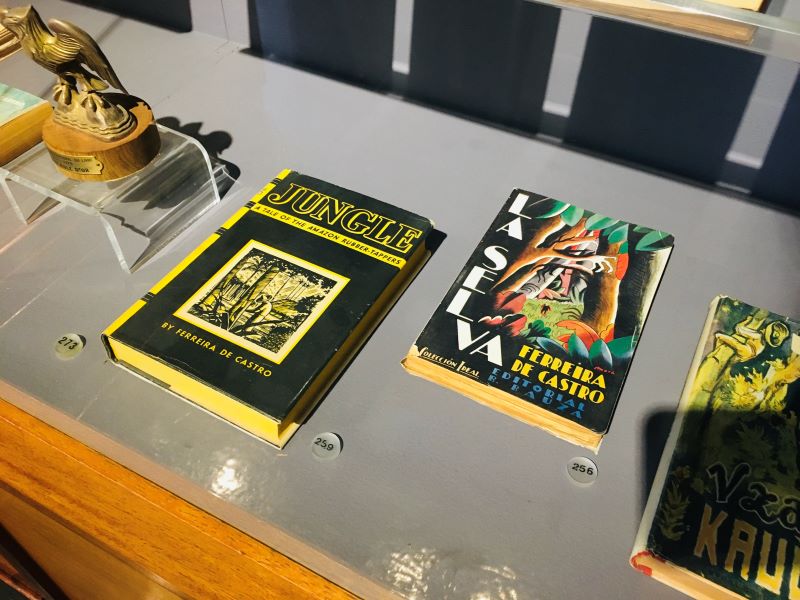An Escapologist’s Diary: Part 77. Escritores de Lisboa

Last week saw a short trip to Lisbon. What an anarchic city. People talk about the ceramic tiles on the fronts of buildings but nobody mentions how it’s all up-and-down and higgledy-piggledy. The cube-shaped cobble stones fan out from their groundings like madmen’s teeth. Near the place we were staying, some graffiti read “Alfama, don’t break your ankles.”
At another spot, the graffiti said “clean is boring.” The city isn’t particularly unclean though: this being continental Europe, the streets are cleaned often enough and the people are evidently proud or smart enough not to drop much litter in the first place. There’s a lot of messy graffiti though, mostly unimaginative tags at shoulder-height. They’ll get that fixed one day: it’ll be the big cosmetic change that makes the city super-liveable like the sandblasting of the tenements in Glasgow in 1990.
I’m not down on the anarchism of Lisbon. I like it. The energy, the hustle and bustle, is great. It feels a bit like being in Asia in some ways. Africa feels tantalisingly close. My walking boots were up to the challenge of not breaking my ankles. I like how the old-fashioned wooden trams rattle around the hilly streets. You’ll be in a café somewhere when the light changes suddenly as the tram blasts by the window.

Anyway, we visited two writers’ museums while we were there: the Saramago Museum in central Lisbon and the Ferreira de Castro Museum in nearby Sintra.
Saramago’s Museum properly befits his memory. Over two floors (plus others of offices administering the cultural foundation that also bares his name) there are multiple editions of his books on display plus photos and documents and his Nobel prize. The giftshop stocks freshly-minted uniform editions of all of his books. His ashes are even interred outside the museum, beneath an olive tree brought in specially from the town of his birth. It’s what every writer dreams of in terms of legacy should their ego allow it. Ridiculous really.
Ferreira de Castro’s museum, however, is far smaller. It’s just a couple of ground floor rooms. There are first editions on display and his typewriter and his little reference library. It’s fine but a bit threadbare. It reminds me of the Jerome K. Jerome Museum in Walsall, which closed down a couple of years after my visit. de Castro was nominated for the Nobel prize but didn’t win it. Can that be the only difference? That Saramago won and de Castro “merely” came close?

I felt bad for de Castro, but proud that he has survived in people’s memory at all; it’s never guaranteed and I can’t imagine Alasdair Gray getting the Saramago treatment in Glasgow despite the intelligent and passionate people who tend his legacy). It felt more important to visit de Castro’s museum than Saramago’s in part because no other bugger was there. Our being counted as attendees pushed back his being condemned to the memory hole by a tiny amount. I vowed to read his books when I got home, starting perhaps with his Nobel-courting A Selva or Jungle (1930). Unfortunately this seems not to be possible. I know his work was translated into English because I saw an English language edition behind glass in the museum, but it’s not easy to find now.
Maybe this is the difference between de Castro and Saramago. That his work didn’t travel far beyond the Portuguese linguasphere? Maybe it’s less likely for a nation to be proud of its writers if they haven’t achieved escape velocity onto the world stage to receive international attention. Certainly his entry on the English-language Wikipedia is a fairly brutal translation of the Portuguese version and the links to his various works (such as the aforementioned A Selva) link only to the Portuguese Wiki, as if nobody beyond that language could possibly be interested.
Not every Nobel nominee can have a museum, I suppose. We’d be overcrowded with them at four new museums a year. But then why not? Nobody complains of there being too many car dealerships and we find ample space to store cat food.
On a similar note, when we visited Lisbon’s Modern Art Gallery, we saw what we thought were new-to-us Man Ray photographs. But no! They were by a Portuguese artist called Fernando Lemos. Once again, he’s every bit as good as Man Ray but he’s barely known in the Anglosphere. There was no Wikipedia entry for him in English at all (until I decided to quickly start one).
There’s all manner of art and culture out there, snowglobed by language. A mind-boggling amount probably. As I know from my own books, the market dictates what gets translated and sold internationally. How good the work might be is usually secondary to marketing considerations. I have no idea why Fernando Lemos didn’t break America while Jose Saramago did. I suppose I can see why Ferreira de Castro didn’t sell overseas since his interests are so resolutely Portuguese, but if people want to read widely, to seek parallels between their own culture and others (or simply to read about other cultures without this need to seek parallels) then we should be able to. I would. Isn’t that what the invisible hand is always seeking? Niche markets?
I read somewhere that Will Self’s practice of using obscure words in his novels isn’t simply to be obnoxious (though I’m sure he enjoys trolling to an extent and living up to his reputation as our foremost sesquipedalian) but to keep older or more obscure ideas in circulation. I admire that. It’s what I would do on a grand scale were I a well-heeled publisher; elevate the marginal, the different, the far-flung, and the experimental. I try to do this in my small way. Pluralism in society is an important thing, like keeping a diverse stock portfolio or eating a balance diet.
This doesn’t have much to do with Escapology, does it? Ah well, it’s my diary. I’m here to show you how I spend my time beyond the world of work. I travel sometimes. I think about books. I write about some of it here.
*
It’s early but you can now pre-order Issue 16 of New Escapologist in print and digital editions.




I had wonderful flashbacks of my trip to Lisbon several years ago while reading this. There are just so many interesting things to look at, so many little nooks to explore and art pieces to enjoy. I think it’s probably the city I most want to go back to. There were parts of the Alfama district where we felt as if we were wandering through people’s outdoor living rooms because of how public and private spaces seem to blend. That’s one of the aspects I most enjoyed: the fact that there were so many spaces that felt communal and shared. A little bit anarchic, as you said. And the fact that it makes no sense to drive around, but to explore at a pedestrian pace. Ah, if I spoke Portuguese, I would seriously consider the move. Perhaps it’s better just to dream.
Dude, those are two very good points. Not sure why I didn’t mention the traffic observation myself and I hadn’t even thought of the public/private spaces being blurred but it’s so true. As a case in point, the place we stayed was on the ground floor and when you open the front door you’re looking right across the narrow street into a coffee shop. I’d open the door to say good morning to the barista while still getting ready to go out. Loved it. Here’s a pic: https://64.media.tumblr.com/9ee66cd3c485501bdf55a11655bff4fb/2981f2f0e84646b5-ee/s1280x1920/daa01629eb86b1c969214b21e3670ba2f9f953d8.jpg
Here’s another shot, out on the street: https://64.media.tumblr.com/669af680c99ab39ac4aaa39faa79f41b/2981f2f0e84646b5-b3/s1280x1920/e171652d41563522c86ef978d5bf02b0022f4166.jpg
Ugh, it’s just so damn cool. Thanks for the photos! One of my fantasies is to retire in such a place and, when I’m old, be like one of those wise grandparent-types who hang the laundry on a balcony and have an hour-long conversation with their neighbors across the alleyway. I want to be a Portuguese grandmother, basically.